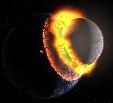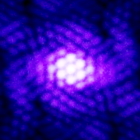|
Microcosmic
|
|
| GibLit | Date: Friday, 05.06.2015, 19:52 | Message # 1 |
|
Observer
Group: Newbies
 Canada
Canada
Messages: 5
Status: Offline
| Now this is probably a farfetched idea, and I don't see it realistically being implemented any time soon, if at all. But nevertheless, this is an idea I had last night.
Ever since I found SE, I have been mesmerized by its scaling. The way I typically explore SE is to turn off all labels and info (basically no words are allowed on my screen), and as a tiny kernal of awareness floating in space, I situate myself in front of an entire galaxy, floating into it slowly. Once a star catches my attention, I gradually make my way toward it and explore, scaling from full view of the star system down to the surfaces of its planets, moons or asteroids. This is a very zen way of playing SE, and it gives me intense wonder and appreciation for the size and scale of the universe.
However, where the scaling stops is at the surface of astral bodies, and it made me think. What if you could get microcosmic, and delve deeper and deeper into smaller and smaller scales. For instance, if you were to zoom into any kind of surface, you would eventually enter a microdimension of molecules, atoms, and so on down to the quantum level. The level of detail this would add to the game would be really cool, to say the least.
What do others think, and would this be feasible in any way?
|
| |
| |
| Alek | Date: Saturday, 06.06.2015, 10:16 | Message # 2 |
 Pioneer
Group: Users
 United States
United States
Messages: 326
Status: Offline
| This would mean a whole new coding, I think, though, because that kind of scaling would require doing a lot with zoom, and asking the question, "should we be able to go through objects in Quantum Mode?" and if this is a yes (which would make seeing this tiny world easier to access) if you forget to turn Quantum Mode off, you might end up in the middle of a planet: not good, except maybe in cases like Europa, but that would require extra coding also.
Living among the stars, I find my way. I grow in strength through knowledge of the space I occupy, until I become the ruler of my own interstellar empire of sorts. Though The world was made for the day, I was made for the night, and thus, the universe itself is within my destiny.
|
| |
| |
| Kermanguy | Date: Saturday, 19.09.2015, 02:20 | Message # 3 |
|
Observer
Group: Newbies
 United States
United States
Messages: 6
Status: Offline
| Space Engine is a game about space, not chemistry or quantum mechanics. Plus, there is no way that any computer system built by mankind, to this date could support such a thing.
|
| |
| |
| anonymousgamer | Date: Saturday, 19.09.2015, 03:20 | Message # 4 |
 World Builder
Group: Global Moderators
 United States
United States
Messages: 1011
Status: Offline
| Quote Kermanguy (  ) Plus, there is no way that any computer system built by mankind, to this date could support such a thing.
Oh they certainly can, and most likely quite easily. But there's pretty much no point and it would take way way way too much time for it to work feasibly, for minimal gain.
Desktop: FX-8350 4.0 GHz, 8 GB DDR3 RAM, EVGA GeForce GTX 1080 FTW 8 GB, 2 TB HDD, 24 inch 1920x1080 screen
Laptop: Core i5 480M 2.66 GHz (turbo 2.93), 8 GB DDR3 RAM, AMD Radeon HD 6550m 1 GB, 640 GB HDD, 17.3 inch 1600x900 screen
|
| |
| |
| Kermanguy | Date: Tuesday, 13.10.2015, 00:20 | Message # 5 |
|
Observer
Group: Newbies
 United States
United States
Messages: 6
Status: Offline
| Quote anonymousgamer (  ) Oh they certainly can, and most likely quite easily.
No. We cannot simulate something in physics that we do not fully understand. That is literally impossible.
|
| |
| |
| Watsisname | Date: Tuesday, 13.10.2015, 03:36 | Message # 6 |
 Galaxy Architect
Group: Global Moderators
 United States
United States
Messages: 2613
Status: Offline
| Our understanding of micro-scale physics (quantum mechanics, standard model) is excellent and incomplete. Our understanding of macro-scale physics (general relativity, concordance model) is excellent and incomplete. Space Engine excels at visualizing the universe on large scales -- from planetary surfaces to galactic clusters and voids. The problem of visualizing the micro-scale in Space Engine is not a problem of having an incomplete understanding of anything. We understand plenty enough to be able to do this, if understanding was all that mattered.
The problem lies with the word "simulating". Space Engine does not simulate physical phenomena. It emulates them.
Consider a star. SE does not simulate nuclear reactions, radiation flow, and pressure balances, and work through the equations of stellar structure to produce a realistic star. Instead, it emulates their external appearance, because there are simple relationships between the mass and age of a star and its size and surface temperature. Without having to simulate anything, SE can build a very convincing star. SE also does not need to simulate the complex processes of star formation to produce a realistic star cluster. It instead generates them according to what we know of actual stellar populations -- what do star clusters look like, and what is the initial mass function?
How about planets? SE does not simulate planetary surface processes or plate tectonics. Instead it emulates them, by using some clever fractal terrain algorithms to produce believable landforms.
I can go on and on with more examples. The reason SE excels at visualizing the macro-scale is because objects and systems on these scales obey patterns and relationships that we can reproduce on the computer, without having to simulate the complicated physics that is actually involved in the real world.
If Space Engine were to evolve to include visualization of the micro-scale, then this implies a huge amount of work. It implies that for every astronomical object, you can fly up to it and see the individual atoms, which means SE must consider its composition. If "quantum mode" means being able to fly through these atoms, then SE has to know the full interior structure. Again, lot of work. Stars would probably be the easiest to adapt to this, as we can use the results of sophisticated simulations of stellar structure to get a good model of the interior of stars according to their mass and age.
But for planets? That would be messy. Very messy. Honestly, I think planets are the most complex objects in the universe next to organisms. And GodTM help you if you are faced with the task of coding SE to include both life and quantum mode. I wouldn't wish that on my worst enemy. 

|
| |
| |